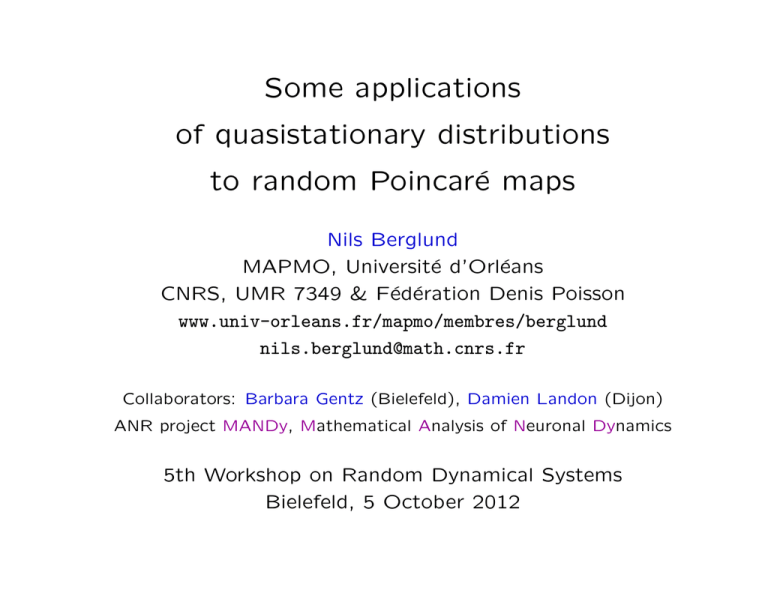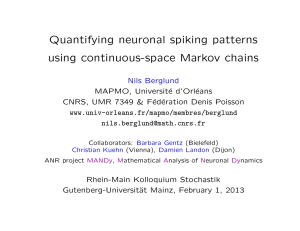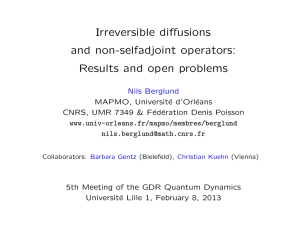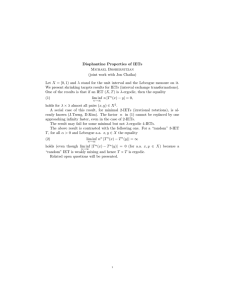Some applications of quasistationary distributions to random Poincar´ e maps
advertisement

Some applications
of quasistationary distributions
to random Poincaré maps
Nils Berglund
MAPMO, Université d’Orléans
CNRS, UMR 7349 & Fédération Denis Poisson
www.univ-orleans.fr/mapmo/membres/berglund
nils.berglund@math.cnrs.fr
Collaborators: Barbara Gentz (Bielefeld), Damien Landon (Dijon)
ANR project MANDy, Mathematical Analysis of Neuronal Dynamics
5th Workshop on Random Dynamical Systems
Bielefeld, 5 October 2012
Random Poincaré map
Stochastic differential equation (SDE)
dϕt = f (ϕt, xt) dt + σF (ϕt, xt) dWt
ϕ∈R
dxt = g(ϕt, xt) dt + σG(ϕt, xt) dWt
x ∈ R (R n)
. all functions periodic in ϕ (say period 1)
. f > c > 0 and σ small ⇒ ϕt likely to increase
. process may be killed when x leaves (a, b)
1
Random Poincaré map
Stochastic differential equation (SDE)
dϕt = f (ϕt, xt) dt + σF (ϕt, xt) dWt
ϕ∈R
dxt = g(ϕt, xt) dt + σG(ϕt, xt) dWt
x ∈ R (R n)
. all functions periodic in ϕ (say period 1)
. f > c > 0 and σ small ⇒ ϕt likely to increase
. process may be killed when x leaves (a, b)
b
x
X1
X2
X0
ϕ
1
2
a
X0, X1, . . . form substochastic Markov chain
1-a
Random Poincaré map and harmonic measure
b
x
X1
X0
−M
ϕ
1
a
. τ : first-exit time of zt = (ϕt, xt) from D = (−M, 1) × (a, b)
. µz (A) = P z {zτ ∈ A}: harmonic measure (wrt generator L)
. [Ben Arous, Kusuoka, Stroock ’84]: under hypoellipticity cond,
µz admits (smooth) density h(z, y) wrt arclength on ∂D
2
Random Poincaré map and harmonic measure
b
x
X1
X0
−M
ϕ
1
a
. τ : first-exit time of zt = (ϕt, xt) from D = (−M, 1) × (a, b)
. µz (A) = P z {zτ ∈ A}: harmonic measure (wrt generator L)
. [Ben Arous, Kusuoka, Stroock ’84]: under hypoellipticity cond,
µz admits (smooth) density h(z, y) wrt arclength on ∂D
. Remark: Lz h(z, y) = 0 (kernel is harmonic)
. For B ⊂ (a, b) Borel set
P X0 {X1 ∈ B} = K(X0, B) :=
Z
B
K(X0, dy)
where K(x, dy) = h((0, x), y) dy =: k(x, y) dy
2-a
Fredholm theory
Let E = [a, b] and consider integral operator K acting
. on L∞ via f 7→ (Kf )(x) =
Z
. on L1 via m 7→ (mK)(A) =
E
Z
k(x, y)f (y) dy = E x[f (X1)]
E
m(x)k(x, y) dx = P µ{X1 ∈ A}
3
Fredholm theory
Let E = [a, b] and consider integral operator K acting
. on L∞ via f 7→ (Kf )(x) =
Z
. on L1 via m 7→ (mK)(A) =
E
Z
k(x, y)f (y) dy = E x[f (X1)]
E
m(x)k(x, y) dx = P µ{X1 ∈ A}
[Fredholm 1903]:
. If k ∈ L2, then K has eigenvalues λn of finite multiplicity
. Eigenfcts Khn = λnhn, h∗nK = λnh∗n form complete ON basis
[Jentzsch 1912]:
. Principal eigenvalue λ0 is real, simple, |λn| < λ0 ∀n > 1, h0 > 0
Spectral decomp: k(x, y) = λ0h0(x)h∗0(y) + λ1h1(x)h∗1(y) + . . .
⇒ P x{Xn ∈ dy|Xn ∈ E} = π0(dy) + O((|λ1|/λ0)n)
where π0 = h∗0/ E h∗0 is quasistationary distribution (QSD)
R
3-a
Fredholm theory
Let E = [a, b] and consider integral operator K acting
. on L∞ via f 7→ (Kf )(x) =
Z
. on L1 via m 7→ (mK)(A) =
E
Z
k(x, y)f (y) dy = E x[f (X1)]
E
m(x)k(x, y) dx = P µ{X1 ∈ A}
[Fredholm 1903]:
. If k ∈ L2, then K has eigenvalues λn of finite multiplicity
. Eigenfcts Khn = λnhn, h∗nK = λnh∗n form complete ON basis
[Jentzsch 1912]:
. Principal eigenvalue λ0 is real, simple, |λn| < λ0 ∀n > 1, h0 > 0
Spectral decomp: k(x, y) = λ0h0(x)h∗0(y) + λ1h1(x)h∗1(y) + . . .
⇒ P x{Xn ∈ dy|Xn ∈ E} = π0(dy) + O((|λ1|/λ0)n)
where π0 = h∗0/ E h∗0 is quasistationary distribution (QSD)
R
3-b
Fredholm theory
Let E = [a, b] and consider integral operator K acting
. on L∞ via f 7→ (Kf )(x) =
Z
. on L1 via m 7→ (mK)(A) =
E
Z
k(x, y)f (y) dy = E x[f (X1)]
E
m(x)k(x, y) dx = P µ{X1 ∈ A}
[Fredholm 1903]:
. If k ∈ L2, then K has eigenvalues λn of finite multiplicity
. Eigenfcts Khn = λnhn, h∗nK = λnh∗n form complete ON basis
[Jentzsch 1912]:
. Principal eigenvalue λ0 is real, simple, |λn| < λ0 ∀n > 1, h0 > 0
∗ (y) + λn h (x)h∗ (y) + . . .
Spectral decomp: kn(x, y) = λn
h
(x)h
0
0
0
1 1
1
⇒ P x{Xn ∈ dy|Xn ∈ E} = π0(dy) + O((|λ1|/λ0)n)
where π0 = h∗0/ E h∗0 is quasistationary distribution (QSD)
R
3-c
Fredholm theory
Let E = [a, b] and consider integral operator K acting
. on L∞ via f 7→ (Kf )(x) =
Z
. on L1 via m 7→ (mK)(A) =
E
Z
k(x, y)f (y) dy = E x[f (X1)]
E
m(x)k(x, y) dx = P µ{X1 ∈ A}
[Fredholm 1903]:
. If k ∈ L2, then K has eigenvalues λn of finite multiplicity
. Eigenfcts Khn = λnhn, h∗nK = λnh∗n form complete ON basis
[Jentzsch 1912]:
. Principal eigenvalue λ0 is real, simple, |λn| < λ0 ∀n > 1, h0 > 0
∗ (y) + λn h (x)h∗ (y) + . . .
Spectral decomp: kn(x, y) = λn
h
(x)h
0
0
0
1 1
1
⇒ P x{Xn ∈ dy|Xn ∈ E} = π0(dx) + O((|λ1|/λ0)n)
where π0 = h∗0/ E h∗0 is quasistationary distribution (QSD)
R
[Yaglom ’47, Bartlett ’57, Vere-Jones ’62, . . . ]
3-d
How to estimate the principal eigenvalue
. “Trivial” bounds: ∀n > 1, ∀A ⊂ E with Lebesgue(A) > 0,
inf K n(x, A) 1/n 6 λ0 6 sup K n(x, E) 1/n
x∈A
x∈E
4
How to estimate the principal eigenvalue
. “Trivial” bounds: ∀n > 1, ∀A ⊂ E with Lebesgue(A) > 0,
inf K n(x, A)
x∈A
1/n
6 λ0 6 sup K n(x, E)
1/n
x∈E
4-a
How to estimate the principal eigenvalue
. “Trivial” bounds: ∀n > 1, ∀A ⊂ E with Lebesgue(A) > 0,
inf K n(x, A)
1/n
x∈A
6 λ0 6 sup K n(x, E)
1/n
x∈E
Z
h0 (y)
∗
dy
6
K(x
, E)
∗)
h
(x
0
E
Z
Z
Z
λ0
h∗0 (y) dy =
h∗0 (x)K(x, A) dx > inf K(x, A)
h∗0 (y) dy
Proof: x∗ = argmax h0 ⇒ λ0 =
A
E
k(x∗ , y)
x∈A
A
4-b
How to estimate the principal eigenvalue
. “Trivial” bounds: ∀n > 1, ∀A ⊂ E with Lebesgue(A) > 0,
inf K n(x, A)
1/n
x∈A
6 λ0 6 sup K n(x, E)
1/n
x∈E
Z
h0 (y)
∗
dy
6
K(x
, E)
∗)
h
(x
0
E
Z
Z
Z
λ0
h∗0 (y) dy =
h∗0 (x)K(x, A) dx > inf K(x, A)
h∗0 (y) dy
Proof: x∗ = argmax h0 ⇒ λ0 =
A
E
k(x∗ , y)
x∈A
A
. Donsker–Varadhan-type bound:
1
where τ∆ = inf{n > 0 : Xn 6∈ E}
λ0 6 1 −
x
supx∈E E [τ∆]
4-c
How to estimate the principal eigenvalue
. “Trivial” bounds: ∀n > 1, ∀A ⊂ E with Lebesgue(A) > 0,
inf K n(x, A)
1/n
x∈A
6 λ0 6 sup K n(x, E)
1/n
x∈E
Z
h0 (y)
∗
dy
6
K(x
, E)
∗)
h
(x
0
E
Z
Z
Z
λ0
h∗0 (y) dy =
h∗0 (x)K(x, A) dx > inf K(x, A)
h∗0 (y) dy
Proof: x∗ = argmax h0 ⇒ λ0 =
A
E
k(x∗ , y)
x∈A
A
. Donsker–Varadhan-type bound:
1
where τ∆ = inf{n > 0 : Xn 6∈ E}
λ0 6 1 −
x
supx∈E E [τ∆]
. Bounds using Laplace transforms
4-d
Laplace transforms
Given A ⊂ E, x ∈ E and u ∈ C , define
τA = inf{n > 1 : Xn ∈ A}
σA = inf{n > 0 : Xn ∈ A}
x [euτA 1
Gu
(x)
=
E
{τA <∞} ]
A
u (x) = E x [euσA 1
HA
{σA <∞} ]
5
Laplace transforms
Given A ⊂ E, x ∈ E and u ∈ C , define
τA = inf{n > 1 : Xn ∈ A}
σA = inf{n > 0 : Xn ∈ A}
x [euτA 1
Gu
(x)
=
E
{τA <∞} ]
A
u (x) = E x [euσA 1
HA
{σA <∞} ]
h
i−1
u
u
. GA(x) is analytic for |e | < supx∈E\A K(x, E \ A)
u
u
. Gu
A = HA in E \ A and HA = 1 in A
. Feynman–Kac-type relation
u = e−u Gu
KHA
A
5-a
Laplace transforms
Given A ⊂ E, x ∈ E and u ∈ C , define
τA = inf{n > 1 : Xn ∈ A}
σA = inf{n > 0 : Xn ∈ A}
x [euτA 1
Gu
(x)
=
E
{τA <∞} ]
A
u (x) = E x [euσA 1
HA
{σA <∞} ]
h
i−1
u
u
. GA(x) is analytic for |e | < supx∈E\A K(x, E \ A)
u
u
. Gu
A = HA in E \ A and HA = 1 in A
. Feynman–Kac-type relation
u = e−u Gu
KHA
A
Proof:
(KHAu )(x)
i
uσA
= E E e 1{σA <∞}
h
h
i
i
x
X1 uσA
x
X1 uσA
= E 1{X1 ∈A} E e 1{σA <∞} + E 1{X1 ∈E\A} E e 1{σA <∞}
= E x 1{τA =1} + E x eu(τA −1) 1{1<τA <∞}
x u(τA −1)
=E e
1{τA <∞} = e−u GuA (x) .
x
h
X1
5-b
Laplace transforms
Given A ⊂ E, x ∈ E and u ∈ C , define
τA = inf{n > 1 : Xn ∈ A}
σA = inf{n > 0 : Xn ∈ A}
x [euτA 1
Gu
(x)
=
E
{τA <∞} ]
A
u (x) = E x [euσA 1
HA
{σA <∞} ]
h
i−1
u
u
. GA(x) is analytic for |e | < supx∈E\A K(x, E \ A)
u
u
. Gu
A = HA in E \ A and HA = 1 in A
. Feynman–Kac-type relation
u = e−u Gu
KHA
A
Consequences:
. If Gu
A varies little in A, it is close to an eigenfunction
5-c
Laplace transforms
Given A ⊂ E, x ∈ E and u ∈ C , define
τA = inf{n > 1 : Xn ∈ A}
σA = inf{n > 0 : Xn ∈ A}
x [euτA 1
Gu
(x)
=
E
{τA <∞} ]
A
u (x) = E x [euσA 1
HA
{σA <∞} ]
h
i−1
u
u
. GA(x) is analytic for |e | < supx∈E\A K(x, E \ A)
u
u
. Gu
A = HA in E \ A and HA = 1 in A
. Feynman–Kac-type relation
u = e−u Gu
KHA
A
Consequences:
. If Gu
A varies little in A, ith is close to an eigenfunction
i−1
. If Kh = e−u h and |eu| < supx∈E\A K(x, E \ A)
then
h
i
x
uτ
h(x) = E e A h(XτA )1{τA<∞}
∀x ∈ E
⇒ h|A determines h|E\A
. If u ∈ R , h > 0 in closed connected A then ∃x∗ ∈ A : GuA(x∗) = 1
5-d
How to estimate the spectral gap
Various approaches: coupling, Poincaré/log-Sobolev inequalities,
Lyapunov functions, Laplace transform + Donsker–Varadhan, . . .
[Birkhoff ’57] Under uniform positivity condition
s(x)ν(A) 6 K(x, A) 6 Ls(x)ν(A)
∀x ∈ E, ∀A ⊂ E
one has |λ1|/λ0 6 1 − L−2
6
How to estimate the spectral gap
Various approaches: coupling, Poincaré/log-Sobolev inequalities,
Lyapunov functions, Laplace transform + Donsker–Varadhan, . . .
[Birkhoff ’57] Under uniform positivity condition
∀x ∈ E, ∀A ⊂ E
s(x)ν(A) 6 K(x, A) 6 Ls(x)ν(A)
one has |λ1|/λ0 6 1 − L−2
Localised version: assume ∃ A ⊂ E and m : A → R ∗+ such that
m(y) 6 k(x, y) 6 Lm(y)
∀x, y ∈ A
(1)
Then
|λ1| 6 L − 1 + O sup K(x, E \ A) + O sup[1 − K(x, E)]
x∈E
x∈A
6-a
How to estimate the spectral gap
Various approaches: coupling, Poincaré/log-Sobolev inequalities,
Lyapunov functions, Laplace transform + Donsker–Varadhan, . . .
[Birkhoff ’57] Under uniform positivity condition
∀x ∈ E, ∀A ⊂ E
s(x)ν(A) 6 K(x, A) 6 Ls(x)ν(A)
one has |λ1|/λ0 6 1 − L−2
Localised version: assume ∃ A ⊂ E and m : A → R ∗+ such that
m(y) 6 k(x, y) 6 Lm(y)
∀x, y ∈ A
(1)
Then
|λ1| 6 L − 1 + O sup K(x, E \ A) + O sup[1 − K(x, E)]
x∈E
x∈A
To prove the restricted positivity condition (1):
. Show that |Yn − Xn| likely to decrease exp for X0, Y0 ∈ A
. Use Harnack inequalities once |Yn − Xn| = O(σ 2)
6-b
Application 1: Exit through an unstable periodic orbit
Planar SDE
dxt = f (xt) dt + σg(xt) dWt
D ⊂ R 2: int of unstable periodic orbit
First-exit time: τD = inf{t > 0 : xt 6∈ D}
Law of first-exit location xτD ∈ ∂D?
D
xτD
7
Application 1: Exit through an unstable periodic orbit
Planar SDE
dxt = f (xt) dt + σg(xt) dWt
D ⊂ R 2: int of unstable periodic orbit
First-exit time: τD = inf{t > 0 : xt 6∈ D}
Law of first-exit location xτD ∈ ∂D?
xτD
D
Large-deviation
principle with rate function
Z T
1
I(γ) =
(γ̇t − f (γt))T D(γt)−1(γ̇t − f (γt)) dt
D = gg T
2 0
Quasipotential:
V (y) = inf{I(γ) : γ : stable orbit → y ∈ ∂D in arbitrary time}
Theorem [Freidlin, Wentzell ’69]: If V reaches its min at a unique
y ∗ ∈ ∂D, then xτD concentrates in y ∗ as σ → 0
7-a
Application 1: Exit through an unstable periodic orbit
Planar SDE
dxt = f (xt) dt + σg(xt) dWt
D ⊂ R 2: int of unstable periodic orbit
First-exit time: τD = inf{t > 0 : xt 6∈ D}
Law of first-exit location xτD ∈ ∂D?
xτD
D
Large-deviation
principle with rate function
Z T
1
I(γ) =
(γ̇t − f (γt))T D(γt)−1(γ̇t − f (γt)) dt
D = gg T
2 0
Quasipotential:
V (y) = inf{I(γ) : γ : stable orbit → y ∈ ∂D in arbitrary time}
Theorem [Freidlin, Wentzell ’69]: If V reaches its min at a unique
y ∗ ∈ ∂D, then xτD concentrates in y ∗ as σ → 0
Problem: V is constant on ∂D!
7-b
Most probable exit paths
Minimisers of I obey Hamilton equations with Hamiltonian
T D(γ)ψ + f (γ)T ψ
H(γ, ψ) = 1
ψ
2
where ψ = D(γ)−1(γ̇ − f (γ))
8
Most probable exit paths
Minimisers of I obey Hamilton equations with Hamiltonian
T D(γ)ψ + f (γ)T ψ
H(γ, ψ) = 1
ψ
2
where ψ = D(γ)−1(γ̇ − f (γ))
pr
s
W+
z0∗
u
W−
∗
z−1
z1∗
∗
z−2
z2∗
∗
z−3
−1
z3∗
s
W−
u
W+
1
r
Generically optimal path (for infinite time) is isolated
8-a
Random Poincaré map
In polar-type coordinates (r, ϕ):
r
1−δ
ϕτ
R1
R0
s∗
ϕ
1
γ∞
9
Random Poincaré map
In polar-type coordinates (r, ϕ):
r
1−δ
ϕτ
R1
R0
s∗
ϕ
1
γ∞
P R0 {Rn ∈ A} = λn
0 h0 (R0 )
Z
A
h
i
∗
n
h0(y) dy 1 + O((|λ1|/λ0) )
If t = n + s,
P R0 {ϕτ ∈ dt} = λn
0 h0 (R0 )
Z
h
i
∗
y
n
h0(y)P {ϕτ ∈ ds} dy 1 + O((|λ1|/λ0) )
Periodically modulated exponential distribution
9-a
Random Poincaré map
r
1−δ
ϕτ
R1
R0
s∗
ϕ
1
γ∞
Split into two Markov chains:
. Chain killed upon r reaching 1 − δ in ϕ = ϕτ−
ϕ −J(ϕ1 )/σ 2
0
s
P {ϕτ− ∈ [ϕ1, ϕ1 + ∆]} ' (λ0)1 e
10
Random Poincaré map
r
1−δ
ϕτ
R1
R0
s∗
ϕ
1
γ∞
Split into two Markov chains:
. Chain killed upon r reaching 1 − δ in ϕ = ϕτ−
ϕ −J(ϕ1 )/σ 2
0
s
P {ϕτ− ∈ [ϕ1, ϕ1 + ∆]} ' (λ0)1 e
. Chain killed at r = 1 − 2δ and on unstable orbit r = 1
−2λ+ T+ (1 + O(δ))
– Principal eigenvalue: λu
=
e
0
λ+ = Lyapunov exponent, T+ = period of unstable orbit
– Using LDP:
−2λ+ T+ (ϕ−ϕ1 )
ϕ−ϕ1 e−[I∞ +c(e
P ϕ1 {ϕτ ∈ [ϕ, ϕ + ∆]} ' (λu
)
0
)]/σ 2
10-a
Main result: cycling
Theorem [B & Gentz, 2012]
|log σ| − θ(ϕ) + O(δ)
r
,0
ϕ
0
P
{ϕτ ∈ [ϕ, ϕ + ∆]} = C(σ)(λ0) χ∆(ϕ)Qλ+T+
λ+T+
h
i
−cϕ/|log
σ|
× 1 + O(e
) + O(δ|log δ|)
11
!
Main result: cycling
Theorem [B & Gentz, 2012]
|log σ| − θ(ϕ) + O(δ)
r
,0
ϕ
0
P
{ϕτ ∈ [ϕ, ϕ + ∆]} = C(σ)(λ0) χ∆(ϕ)Qλ+T+
λ+T+
h
i
−cϕ/|log
σ|
× 1 + O(e
) + O(δ|log δ|)
. QλT (x) =
∞
X
1 e−2x }
A(λT (n − x)) with A(x) = 1
exp{−2x
−
2
2
n=−∞
Cycling profile, periodicised Gumbel distribution
Qλ+ T+ (x)
λ+ T+ = 1
λ+ T+ = 2
λ+ T+ = 10
λ+ T+ = 5
x
11-a
!
Main result: cycling
Theorem [B & Gentz, 2012]
|log σ| − θ(ϕ) + O(δ)
r
,0
ϕ
0
P
{ϕτ ∈ [ϕ, ϕ + ∆]} = C(σ)(λ0) χ∆(ϕ)Qλ+T+
λ+T+
h
i
−cϕ/|log
σ|
× 1 + O(e
) + O(δ|log δ|)
. QλT (x) =
∞
X
1 e−2x }
A(λT (n − x)) with A(x) = 1
exp{−2x
−
2
2
n=−∞
Cycling profile, periodicised Gumbel distribution
. θ(ϕ): explicit function of Drr (1, ϕ), θ(ϕ + 1) = θ(ϕ) + λ+T+
11-b
!
Main result: cycling
Theorem [B & Gentz, 2012]
|log σ| − θ(ϕ) + O(δ)
r
,0
ϕ
0
P
{ϕτ ∈ [ϕ, ϕ + ∆]} = C(σ)(λ0) χ∆(ϕ)Qλ+T+
λ+T+
h
i
−cϕ/|log
σ|
× 1 + O(e
) + O(δ|log δ|)
. QλT (x) =
∞
X
1 e−2x }
A(λT (n − x)) with A(x) = 1
exp{−2x
−
2
2
n=−∞
Cycling profile, periodicised Gumbel distribution
. θ(ϕ): explicit function of Drr (1, ϕ), θ(ϕ + 1) = θ(ϕ) + λ+T+
. λ0: principal eigenvalue, λ0 = 1 − e−V /σ
2
11-c
!
Main result: cycling
Theorem [B & Gentz, 2012]
|log σ| − θ(ϕ) + O(δ)
r
,0
ϕ
0
P
{ϕτ ∈ [ϕ, ϕ + ∆]} = C(σ)(λ0) χ∆(ϕ)Qλ+T+
λ+T+
h
i
−cϕ/|log
σ|
× 1 + O(e
) + O(δ|log δ|)
. QλT (x) =
∞
X
1 e−2x }
A(λT (n − x)) with A(x) = 1
exp{−2x
−
2
2
n=−∞
Cycling profile, periodicised Gumbel distribution
. θ(ϕ): explicit function of Drr (1, ϕ), θ(ϕ + 1) = θ(ϕ) + λ+T+
. λ0: principal eigenvalue, λ0 = 1 − e−V /σ
2
2
. C(σ) = O(e−V /σ )
11-d
!
Main result: cycling
Theorem [B & Gentz, 2012]
|log σ| − θ(ϕ) + O(δ)
r
,0
ϕ
0
P
{ϕτ ∈ [ϕ, ϕ + ∆]} = C(σ)(λ0) χ∆(ϕ)Qλ+T+
λ+T+
h
i
−cϕ/|log
σ|
× 1 + O(e
) + O(δ|log δ|)
. QλT (x) =
∞
X
1 e−2x }
A(λT (n − x)) with A(x) = 1
exp{−2x
−
2
2
n=−∞
Cycling profile, periodicised Gumbel distribution
. θ(ϕ): explicit function of Drr (1, ϕ), θ(ϕ + 1) = θ(ϕ) + λ+T+
. λ0: principal eigenvalue, λ0 = 1 − e−V /σ
2
2
. C(σ) = O(e−V /σ )
u
π
0
. χ∆(ϕ): ∼ P {ϕτ ∈ [ϕ, ϕ + ∆]}, period 1
in linear case χ∆(ϕ) ' θ0(ϕ)∆
11-e
!
Main result: cycling
Theorem [B & Gentz, 2012]
|log σ| − θ(ϕ) + O(δ)
r
,0
ϕ
0
P
{ϕτ ∈ [ϕ, ϕ + ∆]} = C(σ)(λ0) χ∆(ϕ)Qλ+T+
λ+T+
h
i
−cϕ/|log
σ|
× 1 + O(e
) + O(δ|log δ|)
. QλT (x) =
∞
X
1 e−2x }
A(λT (n − x)) with A(x) = 1
exp{−2x
−
2
2
n=−∞
Cycling profile, periodicised Gumbel distribution
. θ(ϕ): explicit function of Drr (1, ϕ), θ(ϕ + 1) = θ(ϕ) + λ+T+
. λ0: principal eigenvalue, λ0 = 1 − e−V /σ
2
2
. C(σ) = O(e−V /σ )
u
π
0
. χ∆(ϕ): ∼ P {ϕτ ∈ [ϕ, ϕ + ∆]}, period 1
in linear case χ∆(ϕ) ' θ0(ϕ)∆
Cycling: periodic dependence on |log σ|
[Day’90, Maier & Stein ’96, Getfert & Reimann ’09]
11-f
!
Main result: cycling
(a)
σ = 0.4, T+ = 2
(c)
σ = 0.5, T+ = 2
V = 0.5, λ+ = 1
(b)
σ = 0.4, T+ = 20
(d)
σ = 0.5, T+ = 5
12
Application 2: Stochastic FitzHugh–Nagumo equations
dxt =
1
σ1
(1)
[xt − x3
+
y
]
dt
+
dW
√
t
t
t
ε
ε
(2)
dyt = [a − xt] dt + σ2 dWt
. x ∝ membrane potential of neuron
. y ∝ proportion of open ion channels (recovery variable)
(1)
(2)
. Wt , Wt : independent
Wiener processes
q
. 0 < σ1, σ2 1, σ =
σ12 + σ22
13
Application 2: Stochastic FitzHugh–Nagumo equations
dxt =
1
σ1
(1)
[xt − x3
+
y
]
dt
+
dW
√
t
t
t
ε
ε
(2)
dyt = [a − xt] dt + σ2 dWt
. x ∝ membrane potential of neuron
. y ∝ proportion of open ion channels (recovery variable)
(1)
(2)
. Wt , Wt : independent
Wiener processes
q
. 0 < σ1, σ2 1, σ =
σ12 + σ22
ε = 0.1
2
δ = 3a2−1 = 0.02
σ1 = σ2 = 0.03
13-a
Application 2: Stochastic FitzHugh–Nagumo equations
dxt =
1
σ1
(1)
[xt − x3
+
y
]
dt
+
dW
√
t
t
t
ε
ε
(2)
dyt = [a − xt] dt + σ2 dWt
. x ∝ membrane potential of neuron
. y ∝ proportion of open ion channels (recovery variable)
(1)
(2)
. Wt , Wt : independent
Wiener processes
q
. 0 < σ1, σ2 1, σ =
σ12 + σ22
σ
ε3/4
Different regimes
σ = δ 3/2
σ = (δε)1/2
σ = δε1/4
[Muratov & Vanden Eijnden ’08]
ε1/2
δ
13-b
Small-amplitude oscillations (SAOs)
Definition of random number of SAOs N :
nullcline y = x3 − x
D
separatrix
P
F , parametrised by R ∈ [0, 1]
14
Small-amplitude oscillations (SAOs)
Definition of random number of SAOs N :
nullcline y = x3 − x
D
separatrix
P
F , parametrised by R ∈ [0, 1]
(R0, R1, . . . , RN −1) substochastic Markov chain with kernel
K(R0, A) = P R0 {Rτ ∈ A}
R ∈ F , A ⊂ F , τ = first-hitting time of F (after turning around P )
N = number of turns around P until leaving D
14-a
Main results
Theorem 1: [B & Landon, 2012]
If σ1, σ2 > 0, then λ0 < 1 and N is asymptotically geometric:
lim P{N = n + 1|N > n} = 1 − λ0
n→∞
15
Main results
Theorem 1: [B & Landon, 2012]
If σ1, σ2 > 0, then λ0 < 1 and N is asymptotically geometric:
lim P{N = n + 1|N > n} = 1 − λ0
n→∞
Theorem 2: [B & Landon 2012]
√
Assume ε and δ/ ε sufficiently small
√
There exists κ > 0 s.t. for σ 2 6 (ε1/4δ)2/ log( ε/δ)
. Principal eigenvalue:
(ε1/4δ)2
1 − λ0 6 exp −κ
σ2
. Expected number of SAOs:
1/4 δ)2
(ε
µ
E 0 [N ] > C(µ0) exp κ
σ2
where C(µ0) = probability of starting on F above separatrix
15-a
Transition from weak to strong noise
Linear approximation near separatrix:
dzt0 =
⇒
δ − σ12/ε
ε1/2
+ tzt0
σ1
σ2
(1)
(2)
dt − 3/4 t dWt + 3/4 dWt
ε
ε
ε1/4 (δ−σ12 /ε)
1/4
q
P{N = 1} ' Φ −π
σ12 +σ22
2
e−y /2
√
dy
Φ(x) =
−∞
2π
Z x
16
Transition from weak to strong noise
Linear approximation near separatrix:
dzt0 =
⇒
δ − σ12/ε
ε1/2
+ tzt0
σ1
σ2
(1)
(2)
dt − 3/4 t dWt + 3/4 dWt
ε
ε
ε1/4 (δ−σ12 /ε)
1/4
q
P{N = 1} ' Φ −π
σ12 +σ22
2
e−y /2
√
dy
Φ(x) =
−∞
2π
Z x
1
0.9
0.8
series
1/E(N)
P(N=1)
phi
∗: P{no SAO}
+: 1/E[N ]
◦: 1 − λ0
curve: x 7→ Φ(π 1/4x)
0.7
0.6
0.5
0.4
0.3
0.2
0.1
0
−1.5
−1
−0.5
0
0.5
1
1.5
2
−µ/σ
16-a
N.B. and Barbara Gentz, On the noise-induced passage through an unstable
periodic orbit I: Two-level model, J. Stat. Phys. 114:1577–1618 (2004).
N.B. and Barbara Gentz, On the noise-induced passage through an unstable
periodic orbit II: General case, preprint arXiv:1208.2557
N.B. and Damien Landon, Mixed-mode oscillations and interspike interval
statistics in the stochastic FitzHugh–Nagumo model, Nonlinearity 25:2303–
2335 (2012). arXiv:1105.1278
Gérard Ben Arous, Shigeo Kusuoka, and Daniel W. Stroock, The Poisson
kernel for certain degenerate elliptic operators, J. Funct. Anal. 56:171–209
(1984).
Garrett Birkhoff, Extensions of Jentzsch’s theorem, Trans. Amer. Math.
Soc. 85:219–227 (1957).
Martin V. Day, Cycling and skewing of exit measures for planar systems,
Stoch. Stoch. Rep. 48:227–247 (1994).
Ivar Fredholm, Sur une classe d’équations fonctionnelles, Acta Math., 27:365–
390 (1903).
Robert Jentzsch, Über Integralgleichungen mit positivem Kern, J. f. d. reine
und angew. Math., 141:235–244 (1912).
Cyrill B. Muratov and Eric Vanden-Eijnden, Noise-induced mixed-mode oscillations in a relaxation oscillator near the onset of a limit cycle, Chaos
18:015111 (2008).
Esa Nummelin, General irreducible Markov chains and nonnegative operators,
Cambridge University Press, Cambridge, 1984.
17









